| |
“La Barnarina understood. Overnight, she weaned the child from her kisses and hugs; bravely, she went from doctor to doctor, among the obscure and among the famous, the empiricals and the homeopaths. All shook their heads, but one of them, however, was good enough to point out a remedy: the glass of lukewarm blood from calves killed that very moment, which consumptive people go to drink, before dawn, over in the slaughterhouses.” |
| |
From The Glass of Blood by Jean Lorrain, 1892 |
If you’ve ever questioned Jean Rollin’s arthouse credentials, the opening sequence of his 1979 Fascination provides plenty of evidence for the defence. It begins with a slow tilt down from a painted portrait to a large and ancient book, one presumably so precious that it’s held closed with metal clasps. The weighty cover is opened by female hands to reveal a first page bearing large and handsomely drawn gothic wording, which the hands run over as if sensually exploring the content by touch. Pages are turned to reveal more text and lithographic drawings that are similarly stroked. Then, just as the hands move to turn to another page, the film cuts abruptly to the main title sequence, which features two white-dressed women dancing on a stone walkway that straddles a body of water to the disconcerting and crackly waltz escaping from a phonograph seated on the ground nearby.
As the music concludes, the film cuts to one of the most exquisitely surrealistic images in all of Rollin’s oeuvre. Inside the glum interior of a dingy abattoir, a woman in clean white Victorian-era clothing stands in motionless wide shot facing the camera, flanked by the hanging carcasses of butchered oxen, the floor beneath her feet liberally spattered with blood. It’s an image that Rollin holds on for just a few seconds longer than theoretically necessary, presenting it almost as a gallery painting for us to linger on and ask questions of. Who is this aristocratic-looking woman, and what possible reason could she have for coming to a place such as this? Seconds later, three other members of her party – two equally well-dressed and predominantly black-clothed women, and a single bowler-hatted man – are led into the slaughterhouse by a rotund butcher. Once inside, the butcher presents each of the women with what looks initially like a glass of red wine but is quickly revealed to be the blood of a slaughtered ox, which they are encouraged by their male companion to drink. It’s here that we learn that the year is 1905, and that ox blood is believed to be the best way to cure anaemia. Before consuming it, one of the women dips a finger in the blood and slowly smears it across her lips as if sensually applying a layer or two of rouge. Once again, Rollin holds on this for longer than regular editing rhythm would normally dictate. The women then drink the blood, and the white-dressed woman smiles.
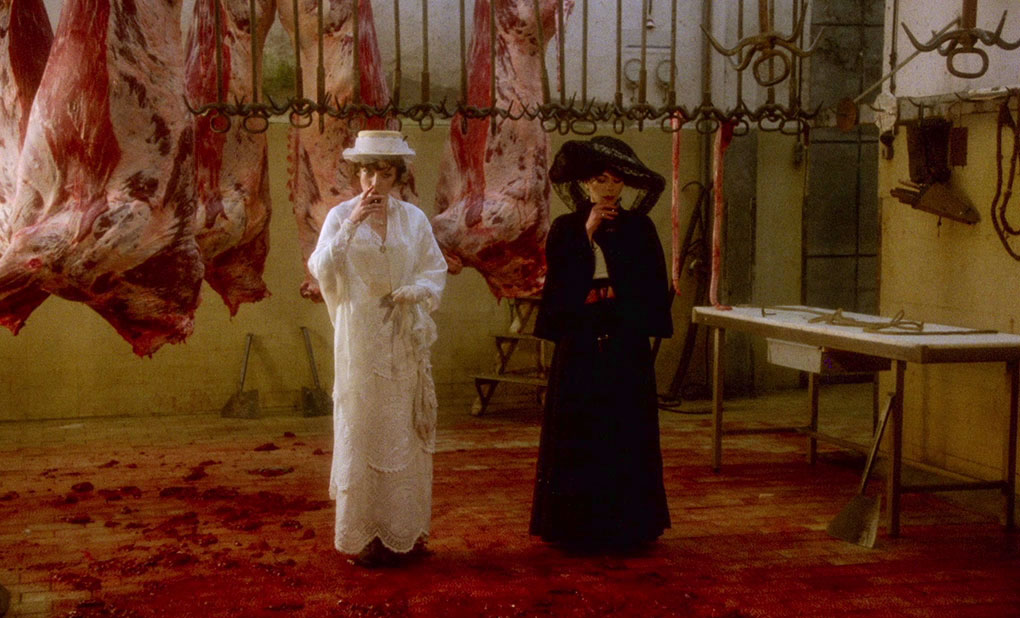
The film then abruptly swaps location again to the interior of barn in which five less aristocratic individuals are gathered. Four of them are outfitted in utilitarian clothing, the fifth, whose name we later learn is Marc, is dressed up like multi-coloured dandy version of Alex in A Clockwork Orange, a comparison enhanced by some small facial similarities between actor Jean-Pierre Lemaire and a young Malcom McDowell. It quickly becomes evident that the five are a gang of thieves and have just robbed someone of a valuable stash of gold coins. Marc suggests that they split up and meet again a month from now, allowing him the time he needs to travel to London and negotiate the sale of their loot. The others are not remotely happy with this arrangement, and when one of them makes a move to strongarm Marc, he draws a hidden pistol and takes the gang’s only female member (Myriam Watteau) hostage, backing out slowly with her and the dosh and then disappearing with both. A gang member who we later learn is the woman’s husband cautions the others against giving chase. “She’s crafty,” he tells them. “She’ll get away.” This she quickly attempts to do, first by ripping open her shirt, massaging her breasts and offering herself to Marc if he’ll let her go, and then, after he loudly laughs and mocks her, by kneeing him sharply in the nuts. This, as you might expect, does the trick. The angry Marc shoots ineffectively at her as she flees, only to then come under fire himself from her companions, who seem to have decided to give chase after all. A bullet wings Marc on the neck and he is forced to run, eventually finding himself at an isolated castle château surrounded by a moat and approachable only via a stone walkway… Hey, wait a minute, haven’t we seen this location before?
With the gang in hot pursuit, Marc enters the château, which although clean and well-furnished, appears to be deserted, but he’s not been there long before he spots a young woman on an upstairs balcony. When he runs up to find her, a second woman exits from a door behind him and runs off in the opposite direction. Marc gives chase and eventually tracks down the attractive Eva (Brigitte Lahaie), whom he interrogates at gunpoint for information on the occupants of the château. She claims to be the lady-in-waiting to the currently absent Marchioness who lives at the castle, and that the other girl is Elisabeth (Franca Maï), the Marchioness’s companion. The smile that slips onto her face as she speaks suggests that she may be spinning Marc a line, one clearly hopes he will be charmed enough by her to believe. When Elisabeth then appears unexpectedly outside the window, Marc runs out and grabs her, and full marks to Franca Maï for the completely convincing struggle that she puts up here. Watching from a distance, meanwhile, are Marc’s four previous partners-in-crime, who make the tactical decision to hang back for now and wait for the right time to pounce and retrieve the gold.
Pressed further for information, Elisabeth and Eva confirm that the Maquis, his wife and their staff are due to return tomorrow, and admit that while the château should be closed, that they like to pretend that it is theirs while the owners are away. Seemingly convinced that the cocksure Marc will do them harm, they tell him to take whatever he wants, but contrary to my every expectation, he elects not take advantage of these attractive, scantily clad and clearly nervous women. Instead, he elects to lock them in their upstairs bedroom and head back downstairs to wait for nightfall in order to make his unseen escape under cover of darkness. Once alone, Eva and Elisabeth break into a fit of giggles and start sensually kissing each other, and when Marc suddenly pops back – for reasons that he chooses not to share – the girls amuse themselves by offering themselves to him in mocking taunts that prompt their captor to huffily depart and relock the door.
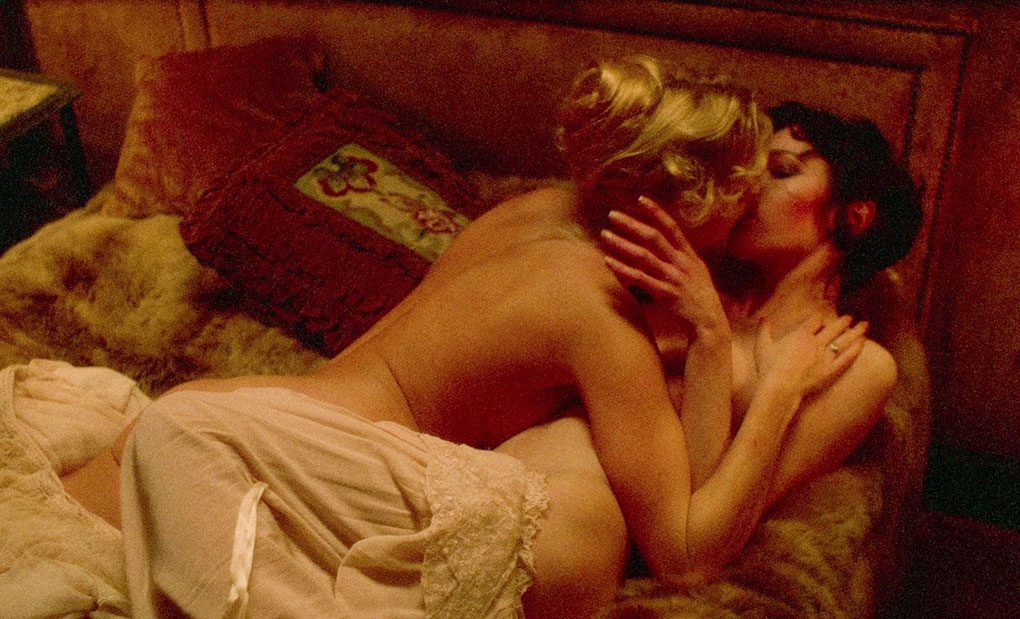
It's then that the film appears to switch genre for a scene that provides a clear reminder of the films that Rollin was making when the funding for his more personal projects ran dry. We’ve already been clued into the fact that Elisabeth and Eva are lovers, but to emphasise the point we’re treated to a lovingly shot softcore lesbian sex scene set to gentle piano music that carries on for long enough to feel a little like it’s been included purely for titillation. Yet it does have narrative purpose, wordlessly confirming the intimate nature of the relationship between Elisabeth and Eva and their passion for each other, while the lingering nature of the sequence is in-keeping with a style that is set in the opening abattoir scene.
It soon becomes evident that Elisabeth and Eva are not just lovers but co-conspirators, and far from being intimidated by Marc, they find him amusing and seem oddly keen that he remain at the château until nightfall when, “a few friends will be coming, the kind of reunion that should remain a secret from the staff.” To this end, Eva once again offers herself to Marc, who once again turns her down to focus on the more urgent business of his escape before finally succumbing to her charms. This leaves the initially miffed Elisabeth to toy thoughtfully with one of the daggers with which she and Eva had playfully threatened Marc a few minutes earlier. “It's too late now,” he muses with ominous poetry, “You’ve stumbled into Elisabeth and Eva’s life. The universe of madness and death. It’s a pity. I think I could have loved you.” Maybe it’s just me, but I adore that line.
If you were to come to the intriguingly titled Fascination with little knowledge of its content and no previous exposure to its director’s work, I have little doubt that you be left wondering what strange and dangerous fate awaits Marc at the hands of these two young women. Approach it with experience of Rollin’s genre back-catalogue, however, and you’re likely to find yourself making some rather specific educated guesses about the true reason for Elisabeth and Eva’s efforts to delay Marc’s departure until night has fallen. The central pairing of two attractive young women who may actually be vampires was certainly by this point less a Rollin trait than his signature motif, and it will be the same story with Elisabeth and Eva is strongly hinted at by the lengths they go to in order to dissuade Marc from leaving before the fall of night. Exactly why this is so important to them remains teasingly uncertain for some time, as the simple fact that they move around freely in daylight makes it unlikely that the two women are vampires after all, at least in the classical sense. And what of their expected visitors, purportedly friends whose identity and presence at the château they claim must remain unknown to others? Marc, who is at this stage of the story trading shots with the gang outside, dismissively assumes that they are talking about secret lovers, but it’s clear from the words and demeanour of the women that they will prove to be nothing of the sort.
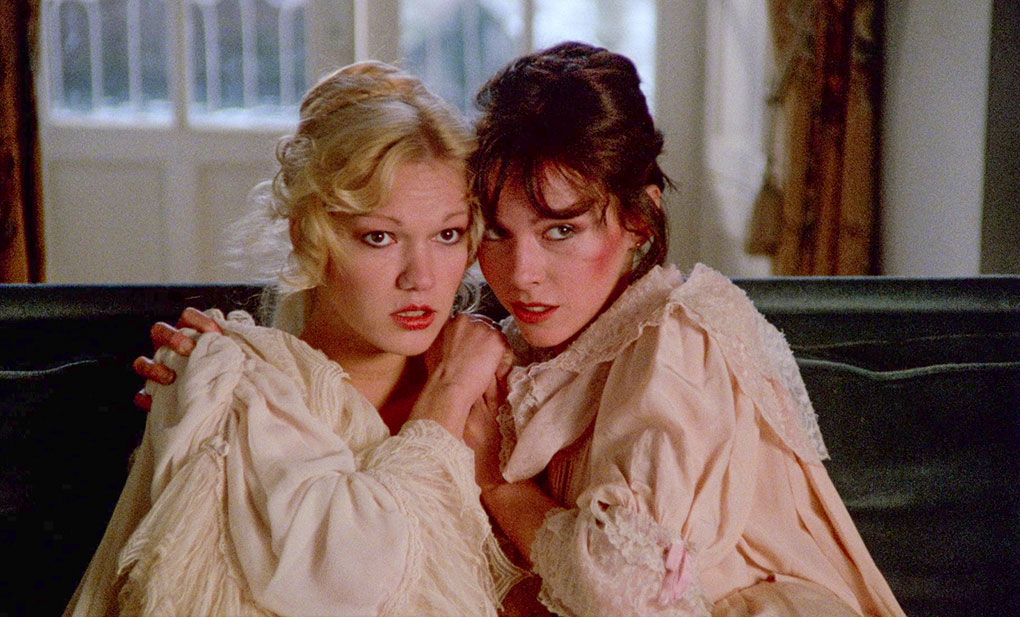
Fascination was clearly a very personal project for Rollin and is one of his purest and most captivatingly dream-like in its look and feel, a sensation enhanced by Philippe d’Aram’s seductive score, which mixes classical music with unsettling synthesiser tonalities and the uniquely haunting choral chords of the Mellotron. Men may seem to be initially calling the shots here, specifically in the actions of the self-assured and pistol-packing Marc (some spoilers ahead – hop to the next paragraph to avoid), and the husband of the female gang member when he, with his amused wife’s full approval, takes Eva into a stable and rapes her. But it becomes increasingly apparent that Elisabeth and Eva are the ones really controlling the narrative here, often in tandem, sometimes independently, but always for an ultimately singular cause. This female empowerment subtext peaks in a sequence that builds to one of the most iconic images in all of Rollin’s filmography, when Eva falls into the hands of the gang, not by being forcibly kidnapped but through her own volition. After she hands the bag of gold to the thieves in the hope that this will prompt them to leave, they insist on counting the contents first, and its she who leads them to the barn in which the assault on her will take place. It’s an action that she appears to stoically go along with but that she uses as a distraction to fatally stab her assailant (in what has to be the most convincing retractable blade screen knifing I think I’ve ever seen), before slaughtering his male companions with a full-sized scythe and turning her attention to her rapist’s wife. The image of her standing off against this woman, dressed in a black robe and brandishing the scythe, is a striking one that became the basis for one of the most memorable posters for any Rollin film (see the UHD cover in the right-hand info bar). This sequence also contains the most potent example of the symbolic use of dark and light visible throughout the film, with characters dressed in white clothing frequently contrasted by companions dressed predominantly in black, while the often identically dressed Elisabeth and Eva are similarly differentiated by opposing hair colours. When Eva confronts the female thief with the scythe, this symbolism is taken a step further to become a metaphor for the stark shift in the balance of power. Having disguised herself in Eva’s dress to more safely approach the house, the thief is now clothed in white, while Eva is dressed in the black cloak on which she lay whilst she was raped by the woman’s husband. Thus, as Eva strides towards her prey, she is visually transformed from a sacrificial angel into an earthbound and vengeful manifestation of Death.
Having worked with Rollin on the 1977 pornographic film Sensual Vibrations [Vibrations Sexuelles] and played a supporting role in his horror feature The Grapes of Death [Les raisins de la mort] the following year, former porn star Brigitte Lahaie really comes into her own as the sensual and ultimately vengeful Eva, and is perfectly matched with Franca Maï as Elisabeth and nicely counterpointed by Jean-Marie Lemaire as the over-confident Marc. With the onset of the promised nocturnal gathering, a new band of characters are introduced. They’re led by the authoritative and goth-like Hélène (Fanny Magier), whose first encounter with Marc sees her deliver the telling line, “Beware, death sometimes takes the form of seduction,” and request that she examine him as if her was her horse. Revisit this scene after watching the rest of the film and the layers of inference really become clear.
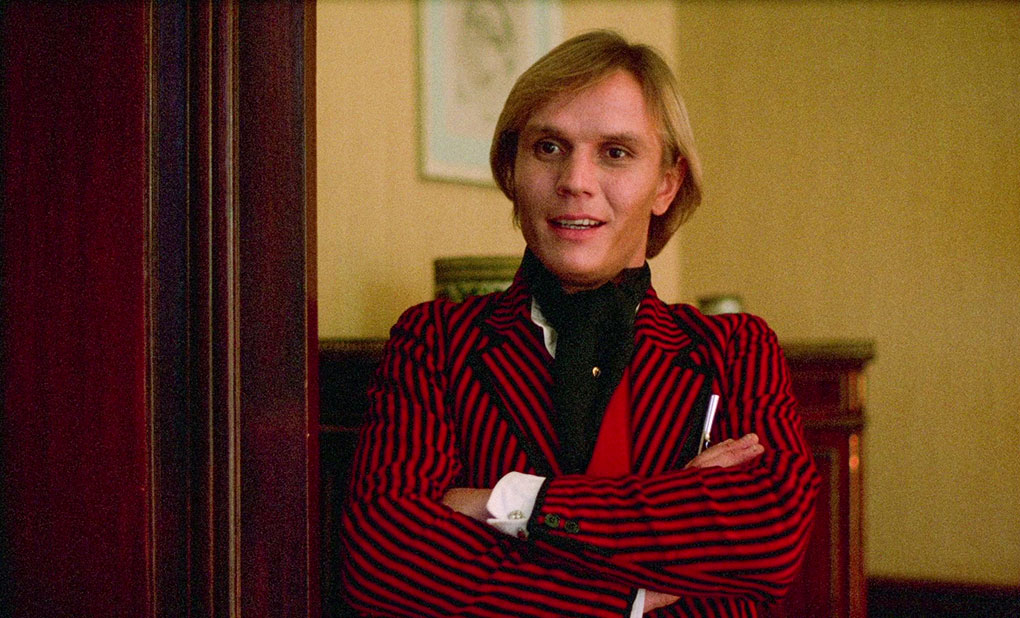
It's not hard to see why devotees of Rollin’s cinema hold Fascination in such high regard. It poetically explores some of his favourite themes but in manner that grounds a seemingly supernatural element it its core in a plausible reality. It intrigues and quietly disconcerts in its first half, then takes on an eerily nightmarish quality in its second as darkness falls, in both temporal and metaphorical terms. Shot, astonishingly, in just two weeks on the sort of budget that wouldn’t provide a day’s worth of catering for a studio film today, Fascination is a film that lives up to the promise of its title, a lyrical and hauntingly surreal work whose surface eroticism is intriguingly subverted by a boldly feminist subtext. The first time I saw it I was intrigued, but by the end of my second viewing I was left in now doubt that this was up there with Rollin’s best.
From the booklet: Fascination was scanned, restored and colour corrected in 4K HDR at Filmfinity, London, using original 35mm negative film materials. Phoenix image-processing tools were used to remove many thousands of instances of dirt, eliminate scratches and other imperfections, as well as repair damaged and missing frames. No grain management, edge enhancement or sharpening tools were employed to artificially alter the image in any way.
And it looks terrific. As with Indicator’s other UHD releases of Jean Rollin films, the Dolby Vision-enhanced 1.66:1 4K image has such a gorgeously film-like texture that there were times when I wanted to lean into the screen and eat it. The crispness of the picture can best be judged by the pin-sharp lace work on Elisabeth and Eva’s white dresses, or the level of visible detail on their jewellery and the individual links of the chain that hangs around Hélène’s neck. The only downside of such sharpness is that shots in which the focus was just slightly soft are all the more visible, but these are rare. The contrast on daylight scenes is often sublime (shots of the four gang members waiting in the château grounds, fro example), and on imagery in which darkness plays in important role – the château exterior at night is a striking example – the transfer delivers the deepest of deep blacks. Colours are attractively rendered, with the dominating warm tones intermittently enlivened by brighter hues, such as the lovely cool blue moonlight that falls onto the château entrance walkway at night or the rich red stripes of Marc’s dandified jacket. The image is clean, and a fine film grain is visible throughout, though this does severely coarsen on a single wide shot when Marc enters a drawing room at night with Elisabeth and Eva at 55:07 – I’m guessing that either this shot was sourced from an alternative original, or was enlarged at the editing stage from a wider shot. It doesn’t last long and does not disrupt the flow.
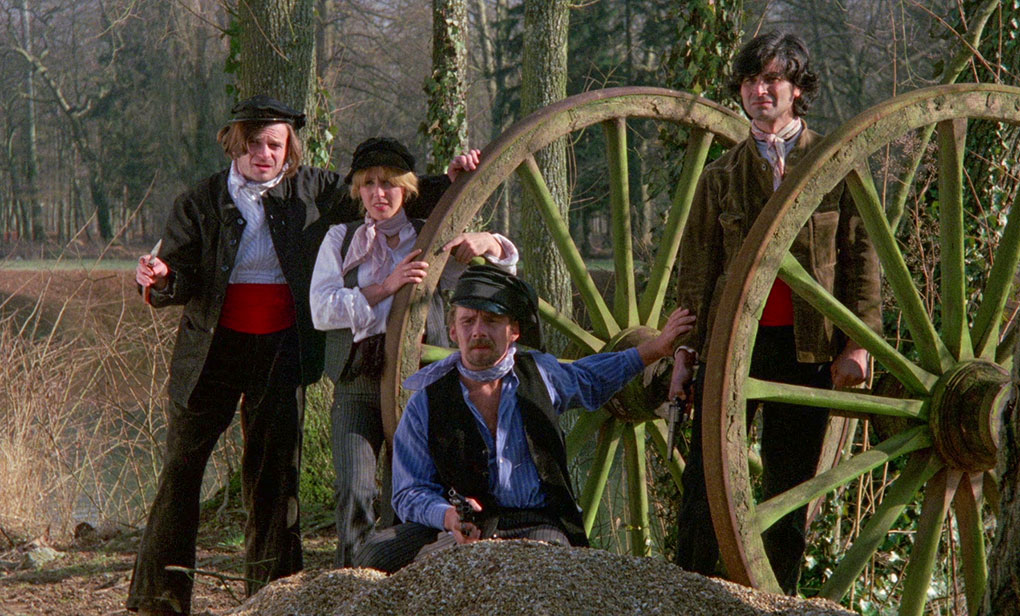
The original French soundtrack is presented as Linear PCM 1.0 mono and is in very good shape, with the dialogue always clear and the music displaying a solid tonal range for a mono track of the period. I detected no obvious signs of wear of damage.
Optional English subtitles are activated by default but can be switched off on the main menu or on the fly using the remote if you so wish.
Audio Commentary with Jeremy Richey
Jeremy Richey, author of the book Sylvia Kristel: From Emmanuel to Chabrol and creator of the blog, Fascination: The Jean Rollin Experience, lays his cards on the table from the start when he describes Fascination as “an incredible film,” a viewpoint that he misses no opportunity to underscore. I have no real problem with that – if you’re passionate about something, why hide it? Areas covered here include the Jean Lorrain short story that inspired the film, how the financial failure of Lips of Blood (1975) saw Rollin return to making porn movies, Rollin’s work and that of his collaborators on the film, the irony that his most critically favoured feature to date was effectively buried by its French distributor, why Brigitte Lahaie should be considered one of the most important figures in French cinema, and much more.
Jean Rollin Introduces ‘Fascination’ (2:21)
A brief introduction to the film from a reclining Jean Rollin, who recalls the film being a great pleasure to make, thanks in part to his lead actresses and a good crew. He confirms that it was shot in just two weeks on a very low budget, and that the press reception was generally positive.
Rituels: ‘Fascination’ (7:42)
A 1979 Salvation Films featurette in which lead actor Brigitte Lahaie and assistant director Nathalie Perrey look back at the making of Fascination, with a very brief contribution from Rollin himself, whose jocular speculation on why Perrey fell into water during the shoot is contradicted in some detail by Perrey herself. She confirms that there was a good atmosphere on set and praises the ‘stunning’ visuals, but criticises the editing (I’m going to have to disagree with her on that one) and some of the acting, a point that is surprisingly seconded by Lahaie.
Philippe d’Aram: The Music of ‘Fascination’ (19:42)
The film’s composer, Philippe d’Aram, recalls that his first job scoring a feature was for a director whose work he was previously unaware of but with whom he would go on to work again on several films, including Rollin’s final feature, Le masque de la Méduse (2009). He discusses some of the instruments used to create score, specifically his primitive synthesiser, his Revox reel-to-reel tape recorder (ah, the nostalgia…) and the Mellotron, an instrument that I’m guessing many younger readers will not even have heard of, and whose possibilities and limitations are explored in fascinating detail here. D’Aram also opines that film music doesn’t have to please the composer, the director, or anybody else (he includes in this list “Alan in England” in his list – we’re guessing this refers to FrightFest organiser and horror devotee Alan Jones), and only has to please the image.
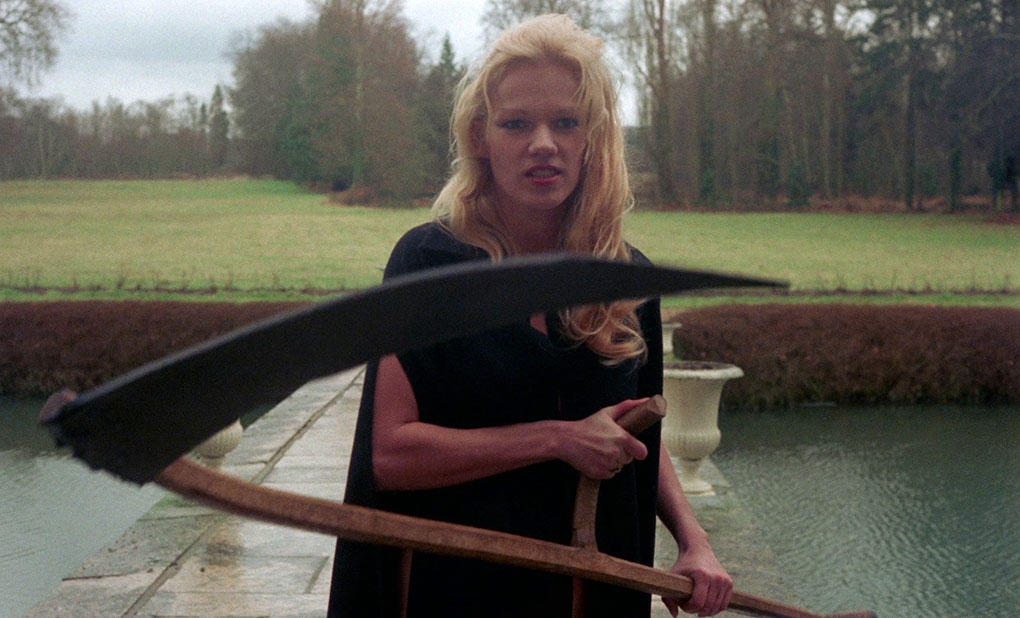
Virginie Sélavy: Love Like Blood (6:51)
Author and film historian, Virginie Sélavy, also touches on the Jean Lorrain short story, but also talks about how Rollin expanded on its narrative in what he himself believed signified a progression for him as a writer. She notes how the film subverts conventions, and talks about the female characters, the château location, and the now iconic image of a scythe-wielding Brigitte Lahaie.
Alternative Sequence #1 (7:54)
The sexual encounter between Marc and Eva that is only shown in brief and largely inexplicit glimpses in the film plays out in full here as a softcore sex scene that teeters on the edge of something stronger. As the film was shot silent, this has no live sound, and this plays instead to extracts from Philippe D'Aram’s score.
Alternative Sequence #2 (7:31)
Hmm. The stable rape scene, but played out for seven-and-a-half minutes as another close-to-hardcore porn sequence, and filmed as if being secretly watched by a sneaky voyeur. Given the sexual assault context, this makes for deeply uncomfortable viewing, and while that may have been Rollin’s intention (the final, forced fellatio certainly feels determinedly unerotic), Irreversible it is not. It did leave me aching for the moment when Eva stabs her wretched assailant, but that’s not included here. Once again, there is no live sound and the sequence is scored with music from the film.
Theatrical Trailer (2:34)
A music-set, dialogue-free collection of disconnected shots from the film that give a flavour of its tone and content but avoids giving even a hint of the plot. It’s not exactly shy about nudity and includes a slow tilt up from the close-up of the stabbing at the end of the stable rape sequence, one that reveals more of actress Brigitte Lahaie’s body than is seen in the film. The expression on Eva’s on which this shot concludes is one of undisguised loathing, which differs the look of satisfied contempt used in the film.
Image Gallery
A manually advanced gallery of 46 stills from film, 21 behind-the-scenes photos, and 5 posters and video covers.
Eurotika!: ‘Virgins and Vampires’ (24:15)
The very first episode from UK TV documentary series Eurotika! – which focussed on erotic, horror and exploitation cult cinema – is all about the cinema and film career of Jean Rollin, and includes an interview with Rollin and briefer chats with actors Cathy Castell, Monica Swinn and Brigitte Lahaie, and Nigel Wingrove of Salvation Films. Just about everything covered here you’ll find explored in far more detail on this and previous Indicator disc releases of Rollin films, but if you’re new to his work, then it makes for a usefully comprehensive introduction. It’s also valuable for its interview footage of Rollin, who concisely differentiates the films that he makes from regular horror cinema with the phrase, “Fantastique is a dream, horror is a nightmare.”
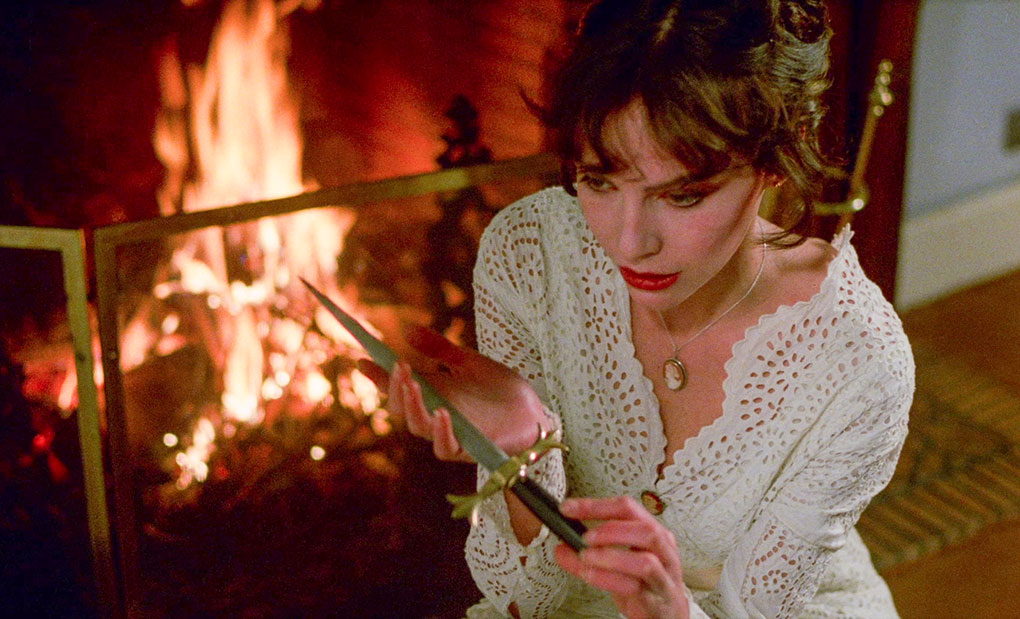
Book
An always essential extra with Indicator releases, the 78-page book included here is especially rich in quality content. It kicks off with an excellent essay on the film by writer and genre expert Vanessa Morgan, in which she examines the film and the influence on it of Dandyism, the sexual revolution of the 1970s, and the rise of feminist movements, as well as discussing the cinematography, the film’s most iconic image, and more. Next we have a brief but welcome introduction to the film written by Jean Rollin in 1997, in which he recalls the project’s inspiration and production, and reveals how he works with actors. The next inclusion is a gem, being a reproduction of the Jean Lorrain short story, The Glass of Blood (Le Verre de sang) that was the unofficial inspiration for Fascination. Descriptively poetic, it bears little narrative resemblance to the story told in the film, but does share some of its key themes, and even suggests some of its imagery. I’m so impressed that Indicator was able to licence this. Next is a 2004 interview with Jean Rollin by Isabelle Marinone from the 2017 edited volume Cinémas libertaires: Au service des forces de transgression et de révolte. This is an extensive interview that covers a lot of ground, including Rollin’s early years, his involvement in revolutionary politics and the artistic avant-garde, the influence of surrealism and key works of literature, his involvement with anarchist theatre, his later films and their reception, and more. Following this is an interview with actress Fanny Magier – who plays the commanding Hélène in the film – by Gene Willow from the September 2020 issue of Escapist’s Advisor. She looks back on her career, and despite a couple of prompts from Willow, only briefly touches on Fascination, but does talk about working with various actors, including Jean-Marie Lemaire (who plays Marc), who became her lover. Details of the restoration and credits for the film are provided, and the booklet is richly illustrated with photos and promotional material.
A film that I ultimately found myself captivated by, for the beauty of its aesthetics, and especially for its potent feminist subtext and the way it ultimately ties all of the narrative elements together, including what initially feels like a completely disconnected opening scene. Indicator has done another fabulous job here, with a pristine 4K transfer and an excellent collection of special features. An absolute must for fans of the cinema of Jean Rollin, and as a member of this collective, I have no problem recommending this one highly.
|